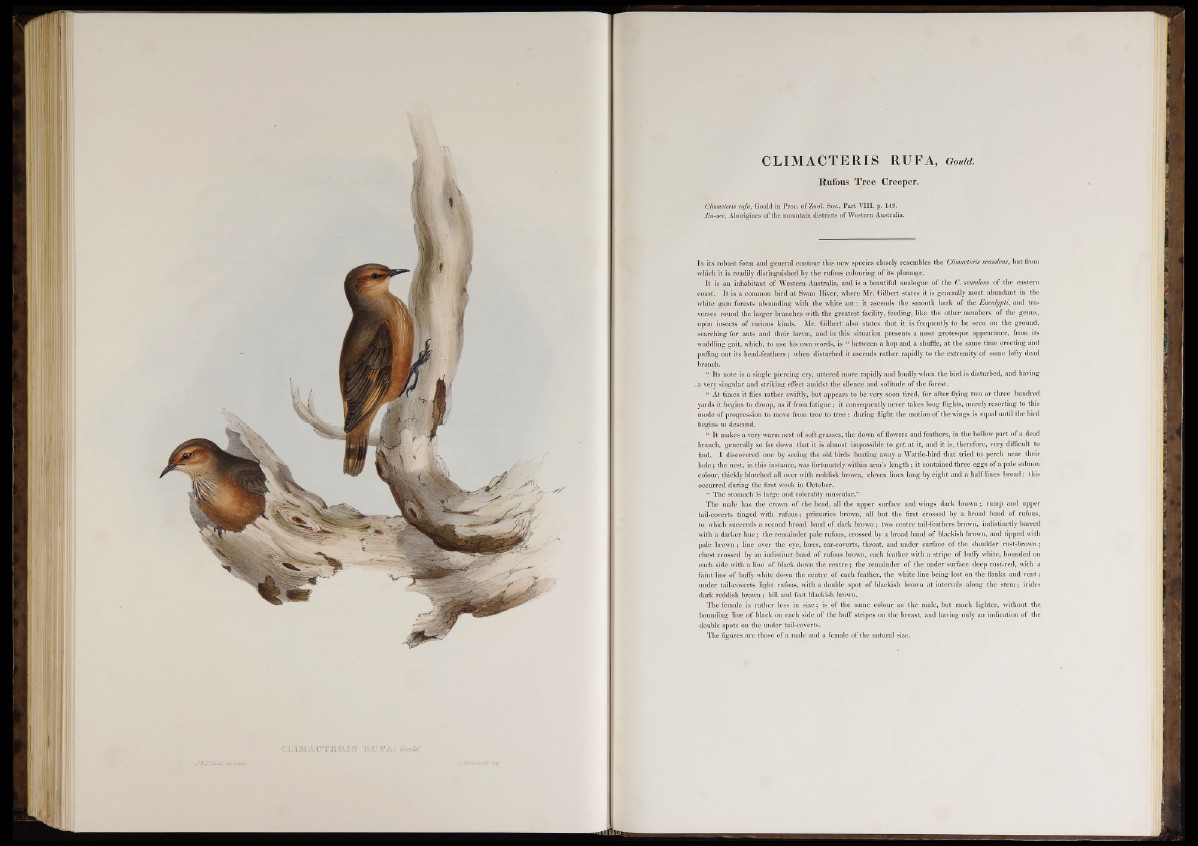
CLIMACTERIS RUFA, —
Rufous Tree Creeper.
Climacteris rufa, Gould in Proc. of Zool. See., Part VIII. p. 149.
Jin-nee, Aborigines of the mountain districts of Western Australia.
In its robust form and general contour this new species closely resembles the Climacteris scandens, but from
which it is readily distinguished by the rufous colouring of its plumage.
It is an inhabitant of Western Australia, and is a beautiful analogue o f the C. scandens of the eastern
coast. It is a common bird at Swan River, where Mr. Gilbert states it is generally most abundant in the
white gum forests abounding with the white an t: it ascends the smooth bark o f the Eucalypti, and traverses
round the larger branches with the greatest facility, feeding, like the other members of the genus,
upon insects of various kinds. Mr. Gilbert also states that it is frequently to be seen on the ground,
searching for ants and their larvae, and in this situation presents a most grotesque appearance, from its
waddling gait, which, to use his own words, is “ between a hop and a shuffle, at the same time erecting and
puffing out its head-feathers; when disturbed it ascends rather rapidly to the extremity of some lofty dead
branch.
“ Its note is a single piercing cry, uttered more rapidly and loudly when the bird is disturbed, and having
a very singular and striking effect amidst the silence and solitude of the forest.
“ At times it flies rather swiftly, but appears to be very soon tired, for after flying two or three hundred
yards it begins to droop, as if from fatigue; it consequently never takes long flights, merely resorting to this
mode o f progression to move from tree to tree : during flight the motion o f the wings is equal until the bird
begins to descend.
“ It makes a very warm nest of soft grasses, the down of flowers and feathers, in the hollow part of a dead
branch, generally so far down that it is almost impossible to get at it, and it is, therefore, very difficult to
find. I discovered one by seeing the old birds beating away a Wattle-bird that tried to perch near their
hole; the nest, in this instance, was fortunately within arm’s length; it contained three eggs of a pale salmon
colour, thickly blotched all over with reddish brown, eleven lines long by eight and a half lines broad: this
occurred during the first week in October.
“ The stomach is large and tolerably muscular.”
The male has the crown of the head, all the upper surface and wings dark brown; rump and upper
tail-coverts tinged with rufous; primaries brown, all but the first crossed by a broad band of rufous,
to which succeeds a second broad band of dark brown; two centre tail-feathers brown, indistinctly barred
with a darker hue; the remainder pale rufous, crossed by a broad band of blackish brown, and tipped with
pale brown; line over the eye, lores, ear-coverts, throat, and under surface o f the shoulder rust-brown;
chest crossed by an indistinct band of rufous brown, each feather with a stripe of bufly white, bounded on
each side with a line of black down the centre; the remainder o f the under surface deep rust-red, with a
faint line of buffy white down the centre o f each feather, the white line being lost on the flanks and vent;
under tail-coverts light rufous, with a double spot o f blackish brown at intervals along the stem 3 irides
dark reddish brown; bill and feet blackish brown.
The female is rather less in size; is of the same colour as the male, but much lighter, without the
bounding line of black on each side of the buff stripes on the breast, and having only an indication of the
double spots on the under tail-coverts.
The figures are those of a male and a female of the natural size.